
|
After a two-year absence, the Southern California Timing Association and competitors were back at the Bonneville Salt Flats for Speed Week 2016.
Poor salt conditions and inclement weather prevented the event from taking place in 2014 and 2015.
The 2018 event held from August 11 – 17 was the 70th running of Speed Week.
There was an entry list of over 400-competitors coming from as far away as Australia and New Zealand and as close as Canada.
Vehicles racing at the Salt Flats compete in one of seven broad categories depending on their construction and the technology employed.
Within each category are a number of classes.
- Special Construction Category: This represents vehicles competing within the quickest classes.
These are hand constructed vehicles not modified production cars.
Within in this class, there are Streamliners (covered-wheels) and Lakesters (open wheels).
Modes of power in these classes are gasoline, diesel, electric and turbine engines.
- Vintage Category: This category is for cars produced before 1948.
- Classic Category: This category is restricted to coupes and sedans produced been 1928 and 1981.
Minimal modifications are allowed to the bodywork and engine management systems are limited to OEM designs.
- Modified Category: This category includes domestic and foreign coupes and sedans.
These vehicles have been modified so that they do not meet the rules of other categories.
- Production Category: Vehicles in this category have a very limited number of modifications.
It includes – production based coupes, sedans, grand touring sports cars and pickups with different induction systems.
- Diesel Truck Category: This a catchall for diesel trucks constructed with varying degrees of technology.
- Motorcycle Category: This category includes production, modified, special construction, streamliner and sidecar classes.
Within each category there are a number of classes – speed records are set for classes.
Classes are determined by attributes such as engine displacement, fuel type, induction system, body style and modifications, etc.
For those in attendance during the week, it was an opportunity to see records broken and broken again.
The highlight of the Speed Week was Danny Thompson breaking his father’s 48-year-old Bonneville record.
|
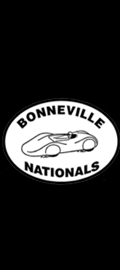
|
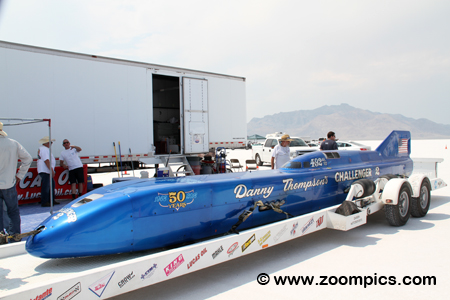
|
Danny Thompson, the son of drag racing legend Mickey Thompson, broke the speed record that his father set in1968 with a
combined pass of 448.757-mph. Thompson drove the Challenger 2 which was built in 1968. The car had been sitting in storage for
22-years before, he decided to restore it at the cost of $2MM. This Streamliner is powered by two nitro-fueled 500-cu.in.
Hemi engines which produce 2,500-horsepower.
|

|

|
Vehicles attempting land speed records come in all shapes and sizes. This is a 1972 Honda Z600.
The Z600 referred to the car’s engine displacement which is 598-cc or 36-cu.in.
The two-cylinder over-cam engine produces 36-horsepower.
The Honda, owned and driven by Michael Turner has been fitted with a 61-cu.in. which does not fit neatly into the engine bay.
The car competes in the Gas Competition Coupe category.
|

|
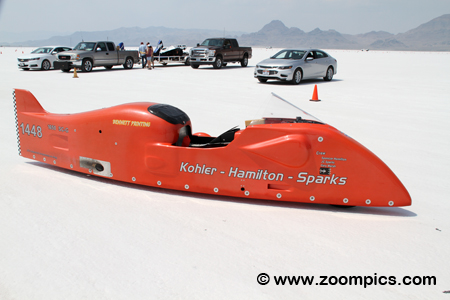
|
This 2010 Sidecar from Kohler – Hamilton – Sparks is owned and driven by La Luz, New Mexico’s, Wally Kohler.
Sidecar entries were particularly popular at this year’s Speed Week – it probably a lot easier to keep a three-wheel motorcycle upright.
The Kohler – Hamilton – Sparks sidecar is powered by a 1534-cc Kawasaki engine and competes in the 1650-cc motorcycle category.
It reached a speed of 227.520-mph during the week.
|

|
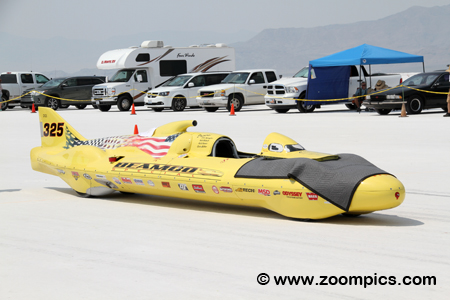
|
Competing in the Gas Streamliner category is the Beamco Special which is owned and driven by Bob Blakely.
This streamliner uses a 305-cu.in. Chevrolet engine.
The current record for the D/GS class is 310.981-mph and was set in September 2011 by Team Vesco.
Blakely fell short of the record, turning a speed of 302.391-mph.
|

|
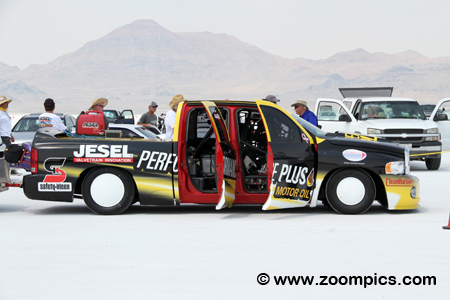
|
Jesel Incorporated out of Lakewood, New Jersey specialises in aftermarket performance valvetrain components
(rockers, belt drives, lifters, etc.). This 2005 Dodge Ram Pickup equipped with a 502-cu.in. General Motors
DRCE 2 engine serves as a testbed for valvetrain innovation.
The driver, Jimmy Barton was able to reach a speed of 230.093-mph at this year’s event while competing in the AA/BMP class.
|

|
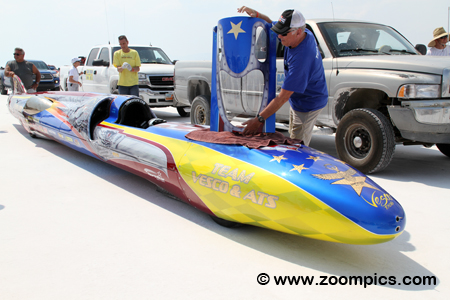
|
Team Vesco brought the Turbinator II to the salt flats to break their record of 427.832-mph set by the late,
Don Vesco – their goal is to exceed 500-mph. This special construction Streamliner which debuted in 2013 is
powered by a Lycoming T-55 Turbine which produces 4,300-horsepower.
The Turbinator’s current driver is Dave Spangler who has extensive experience in all forms of motorsport.
Spangler’s best run was 455.106-mph.
|

|
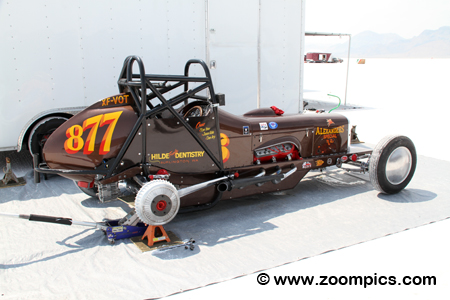
|
You have to expect that an 80-year-old race car is going require some attention. This is a 1938 Miller.
The vehicle was designed and built by Harry Miller. Between 1922 and 1938 Miller’s cars and engines won twelve Indy 500s.
The entry from Four Horse Racing uses a 286-cu.in. Ford Flathead V8.
Driven by the owner, Craig Johnson the Miller competed in the Vintage Oval Track category. Johnson achieved a speed of 129.803-mph.
|

|
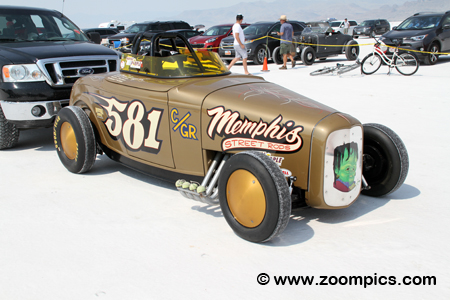
|
This Nish Motorsports Gas Roadster recorded a top speed of 197.084-mph during the August event.
The current record for vehicles prepared to C/GR rules is 236.995-mph.
The Nish entry is a 1932 Ford Roadster powered by a 367-cu.in. Ford V8.
The Roadster was driven at the Bonneville Speed Week by Andy Nish and Larry Lawson.
This local car is owned by Terry Nish and George Poteet (driver of the Speed Demon).
|

|
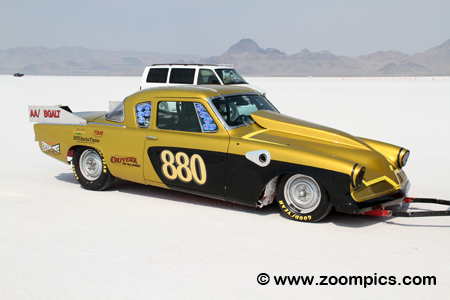
|
Based on the shape of the fourth generation two-door Studebaker Champion (built from 1953-1956) it
appears that the car was designed specifically for Land Speed records.
Despite the age of this model, there were many of them entered at this year’s Speed Week.
This example is a 1953 Champion powered by a 515-cu.in. Merlin V8.
This is a Canadian entry from British Columbia owned and driven by Shawn Driver.
|

|
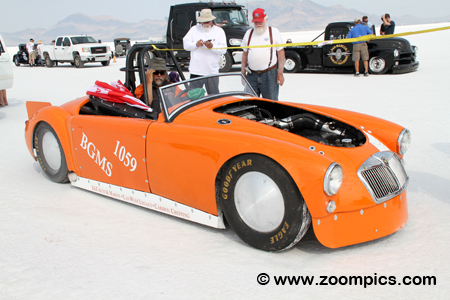
|
Another entry from Canada is this MGA – fitting called MG ‘EH’.
The MGA, originally introduced in 1955, was equipped with a four-cylinder 1489-cc engine.
Subsequent models were fitted with 1588-cc and 1622-cc motors.
This MGA owned by Hal Bamping and Rick Bell uses a 376-cu.in. Chevrolet V8.
It competed in the Blown Fuel Modified Sports category where the class record is 233.988-mph.
|

|
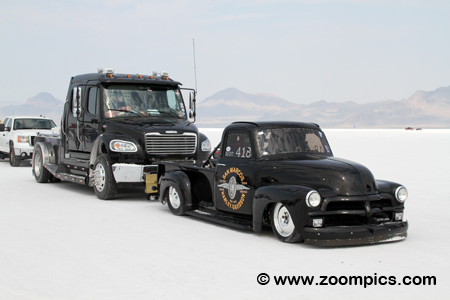
|
This very clean setup was from Pilgrim and Stubbs Racing out of Rockport, Texas.
This 1954 Chevrolet Pickup was prepared for the Diesel Truck category – B/DT class.
The record for the class, set last year by Salty Box Racing, is 213.899-mph.
The Pilgrim and Stubbs truck which is fitted with a 403-cu.in.
Duramax reached a top speed of 202.582-mph with driver David Pilgrim behind the wheel.
|

|
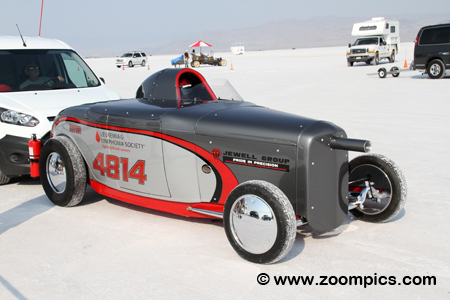
|
One of the many Gas Roadster entries was this beautifully prepared 1932 Ford Roadster using a 304-cu.in. Ford Flathead V8.
The Jewell Motorsports team was going after the XF/GR record of 161.081-mph set by Makuch Racing in 2012.
Owner/driver Matt Jewell from Bettendorf, Iowa fell well short of the speed required, his best run was during Speed Week was 141.342-mph.
|

|
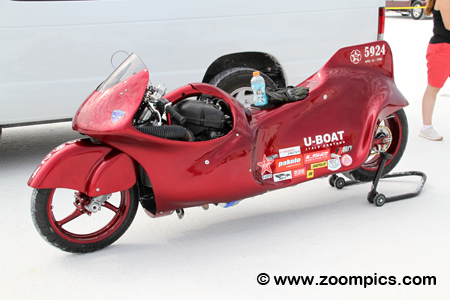
|
Just like the cars and trucks competing at Bonneville, motorcycles come in all shapes and sizes.
This is the 1997 Triumph Omega and it competes in a very broad category for Electric/Steam/Turbine motorcycles.
Team owner, Dino Luciano Romano along with riders, Dominico Fasanella and Alessandro Bongiovanni were attempting
to set a speed record for engines powered by natural gas – their best pass was 172.489-mph.
|

|
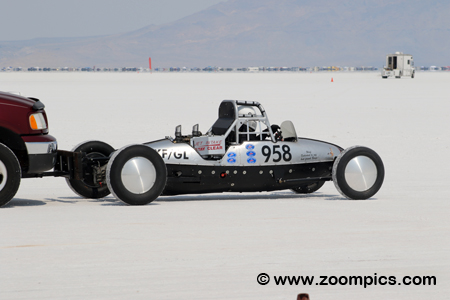
|
This is entry is a Belly Tank Lakester which became popular at Bonneville after WWII.
No. 958 is owned and driven by Californian, Joe Streng. Streng’s Belly Tank Lakester is powered by a 149-cu.in. Ford Flathead V8.
The class record for XF/CL is 196.557-mph and was set in 2003 by the Spirit of Modesto team.
Streng encountered issues during the event and recorded a speed of only 81.269-mph.
|

|
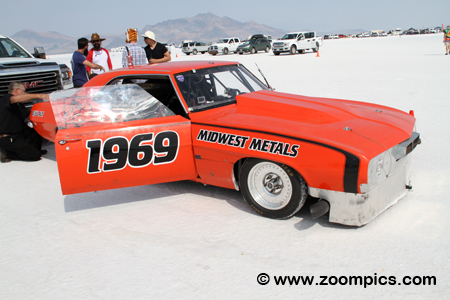
|
This 1969 Chevrolet Camaro was sponsored by Midwest Metals.
The owners and drivers, Fred and Renee Baughman, were chasing the record set by the Original Fast Guys of 253.202-mph.
To achieve their goal the B/CALT class Camaro uses a 427-cu.in. V8 Chevrolet engine.
The best run occurred on August, 14 and was only 172.411-mph.
|

|
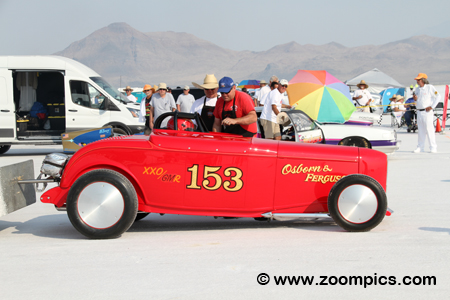
|
The speed to beat to beat in the XXO/STR class was 169.491-mph set by Lee Tull 27-years ago.
The Osborn & Ferguson Roadster is a 1932 Ford which utilizes a 302-cu.in. GMC inline 6-cylinder motor.
Mission accomplished, on August, 16 the team’s driver, Tyler Osborn established a new speed record of 179.703-mph.
|

|
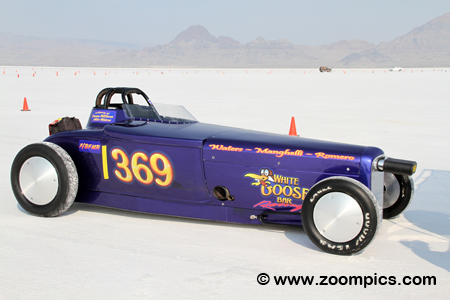
|
The Roadster categories were well represented at this year’s Speed Week.
The Waters – Manghelli – Romero 1929 Ford Roadster was the record holder in the D/BGR class at 231.358-mph.
This particular car was powered by a 3.0-liter Toyota six-cylinder.
Sharing the driving duties were Greg Waters, Gerard Collier and Sean Romero.
On August, 12th Waters went 248.755-mph and on the 14th, Collier went 242.887-mph.
|

|

|
Another Roadster, this one was entered by the driver Heath Murray.
The 1934 Ford Roadster with a 262-cu.in. Ford Flathead V8 competed in the Blown Fuel Roadster category.
The team was hoping to beat the XF/BFR class record of 189.785-mph set by the Hogan, Martin and Rea entry of 189.785-mph in 2006.
The best Murray could manage, was a pass of 184.858-mph.
|

|
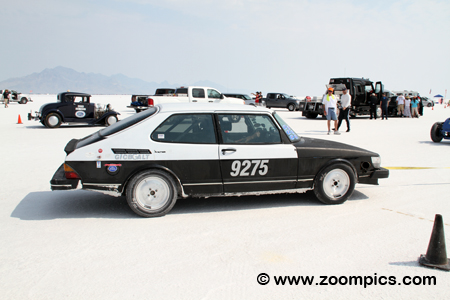
|
Landjet entered the No. 9275 1981 Saab 900.
The 900 model known as the ‘Classic’ was produced from 1978 – 1993.
The Landjet Saab is powered by a 2-liter engine – during the years the car was sold there were three different
2-liter motors manufactured (B14, B201 and B202). Competing in the G/CBALT class for Classic Blown Gas Altered cars,
drivers Dan Haugh and Bryan Harris were able to go 98.036-mph.
|
|
Copyright Notice:
|
All content (photographs and text) appearing on this website are the exclusive property of © www.zoompics.com and are protected under International copyright laws. The subject matter on this website may not be reproduced, copied, stored or manipulated.
|
© Copyright 1999, 2000, 2001, 2002, 2003, 2004, 2005, 2006, 2007, 2008, 2009, 2010, 2011, 2012, 2013, 2014, 2015, 2016, 2017 and 2018


